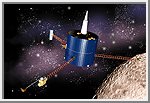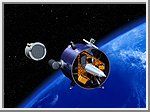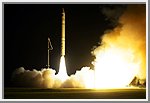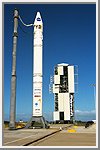
NASA Lunar Orbiter
Courtesy of NASA's National Space Science Data Center
| Table of Contents | Related Information |
Launch Date/Time: 1998-01-07 at 02:28:44 UTC
On-orbit dry mass: 126.00 kg
Nominal Power Output: 202.00 W
Introduction
The Lunar Prospector is designed for a low polar orbit investigation of the Moon, including mapping of surface composition and possible deposits of polar ice, measurements of magnetic and gravity fields, and study of lunar outgassing events. Data from the 1 to 3 year mission will allow construction of a detailed map of the surface composition of the Moon, and will improve our understanding of the origin, evolution, current state, and resources of the Moon. The spacecraft will carry 6 experiments: a Gamma Ray Spectrometer (GRS), a Neutron Spectrometer (NS), a Magnetometer (MAG), an Electron Reflectometer (ER), an Alpha Particle Spectrometer (APS), and a Doppler Gravity Experiment (DGE). The instruments are omnidirectional and require no sequencing. The normal observation sequence will be to record and downlink data continuously.The spacecraft is a graphite-epoxy drum, 1.4 meters in diameter and 1.22 meters high with three radial instrument booms. It will be spin-stabilized and controlled by 6 hydrazine monopropellant 22-Newton thrusters. The power system consists of body mounted solar cells and 15 amp-hr NiH batteries. Communications are through two S-band transponders and a slotted, phased-array medium gain antenna and omnidirectional low-gain antenna. There will be no on-board computer. Total initial mass (fully fueled) is 295 kg.
Following launch on 7 January 1998 UT (6 January EST) aboard a three-stage Athena 2 rocket, the Lunar Prospector had a 105 hour cruise to the Moon. During the cruise, the three instrument booms were deployed. The MAG and APS collected calibration data, while the GRS, NS, and ER outgassed for one day, after which they also collected calibration data in cis-lunar space. The craft was inserted into an 11.6-hour period capture orbit about the Moon at the end of the cruise phase. After 24 hours Lunar Prospector was inserted into a 3.5-hour period intermediate orbit, followed 24 hours later (on 13 January 1988) by tranfer into a 92 x 153 km preliminary mapping orbit, and then on 16 January by insertion into the near-circular 100 km altitude nominal lunar polar mapping orbit with an inclination of 90 degrees and a period of 118 minutes. Lunar calibration data was collected during the 11.6- and 3.5-hour orbits. Lunar mapping data collection started shortly after the 118 minute orbit was achieved. The data collection will be periodically interrupted during the mission for orbital maintenance burns, which will take place to recircularize the orbit whenever the periselene or aposelene is more than 20 to 25 km from the 100 km nominal orbit, about once a month. The nominal mission is planned for one year, with a possible additional two years for the extended mission. The extended mission involves plans for lowering the circular orbit to 50 km altitude and then to 10 km altitude to perform higher resolution studies.
The Lunar Prospector mission has been selected by NASA for full development and construction as part of NASA's Discovery program. This program funds spacecraft that can be developed in less than three years for under $150 million.
Scientific Investigations
The gamma ray spectrometer and the neutron spectrometer will return global data on elemental abundances, which will be used to help understand the evolution of the lunar highland crust and the duration and extent of basaltic volcanism, and to assess lunar resources. The neutron spectrometer will be used to locate any significant quantities of water ice which may exist in the permanently shadowed areas near the lunar poles.
The magnetometer/electron reflectometer experiments will return data on the lunar crustal magnetic field and the lunar induced magnetic dipole. This data will help provide an understanding of the origin of lunar paleomagnetism and the degree to which impacts can produce paleomagnetism, and allow constraints on the size and composition of the (possible) lunar core.
The alpha particle spectrometer instrument will be used to find radon outgassing events on the lunar surface by detecting alpha particles from the radon gas itself and its decay product, polonium. Observations of the frequency and locations of the gas release events will help characterize one possible source of the tenuous lunar atmosphere. Determination of the relationship of outgassing sites with crater age and tectonic features may be possible. This may in turn be used to characterize the current level of lunar tectonic activity.
The Doppler gravity experiment will use Doppler tracking of S-Band radio signals to characterize the spacecraft orbit and determine the lunar gravity field. These data will provide information on the lunar interior and, combined with lunar topographic data, will allow modelling of the global crustal asymmetry, crustal structure, and subsurface basin structure. The data can also be used for planning future lunar missions.
 Lunar Prospector in Orbit
Lunar Prospector in Orbit
This artist's conception of Lunar Prospector shows the Spacecraft in
lunar orbit with its instrument masts fully deployed. Prospector's
primary mission will keep the spacecraft in a 100 km polar mapping
orbit for a full year or more. This orbit will provide higher quality
science data than has previously been obtained. Prospector has an
Extended Mission option of a 10km, very high resolution orbit for
a brief period of time.
(Courtesy NASA)
 Lunar Prospector at Separation
Lunar Prospector at Separation
A little over an hour after Prospector has been launched, the
translunar injection stage (or kick motor) will fire, separating
it from the spacecraft. At this point, the mission timeline
officially begins, and power is turned on to all systems except
the instruments.
(Courtesy NASA)
 Lunar Prospector Launch
Lunar Prospector Launch
NASAs Lunar Prospector spacecraft launched successfully on its way to
the moon from Launch Complex 46 (LC46) at Cape Canaveral Air Station
on January 6, 1998 at 9:28 p.m. EST. It was the inaugural launch of Lockheed
Martin's Athena II launch vehicle and the first launch from LC46,
operated by Spaceport Florida Authority. Lunar Prospector, built for
the NASA Ames Research Center by Lockheed Martin, is a spin-stabilized
spacecraft designed to provide NASA with the first global maps of the
moons surface and its gravitational magnetic fields, as well as look
for the possible presence of ice near the lunar poles. It will orbit
the Moon at an altitude of approximately 63 miles during a one-year mission.
(Courtesy NASA/KSC)
 Lunar Prospector Launch
Lunar Prospector Launch
NASAs Lunar Prospector spacecraft launched successfully on its way to
the moon from Launch Complex 46 (LC46) at Cape Canaveral Air Station
on January 6, 1998 at 9:28 p.m. EST. It was the inaugural launch of Lockheed
Martin's Athena II launch vehicle and the first launch from LC46,
operated by Spaceport Florida Authority. Lunar Prospector, built for
the NASA Ames Research Center by Lockheed Martin, is a spin-stabilized
spacecraft designed to provide NASA with the first global maps of the
moons surface and its gravitational magnetic fields, as well as look
for the possible presence of ice near the lunar poles. It will orbit
the Moon at an altitude of approximately 63 miles during a one-year
mission.
(Courtesy NASA/KSC)
 Prospector is readied for launch
Prospector is readied for launch
NASAs Lunar Prospector is readied for launch as its gantry-like
service tower is rolled back again at Cape Canaveral Air Stations
Launch Complex 46. The launch, previously scheduled for January 5, 1998,
was postponed one day due to a problem with a range safety radar
located at Patrick Air Force Base, Florida Lunar Prospector, built
for the NASA Ames Research Center by Lockheed Martin, is a
spin-stabilized spacecraft designed to provide NASA with the first
global maps of the Moons surface and its gravitationa lmagnetic
fields, as well as look for the possible presence of ice near the
lunar poles. It will orbit the Moon at an altitude of approximately
63 miles during a one-year mission.
(Courtesy NASA/KSC)

 Space History
Space History